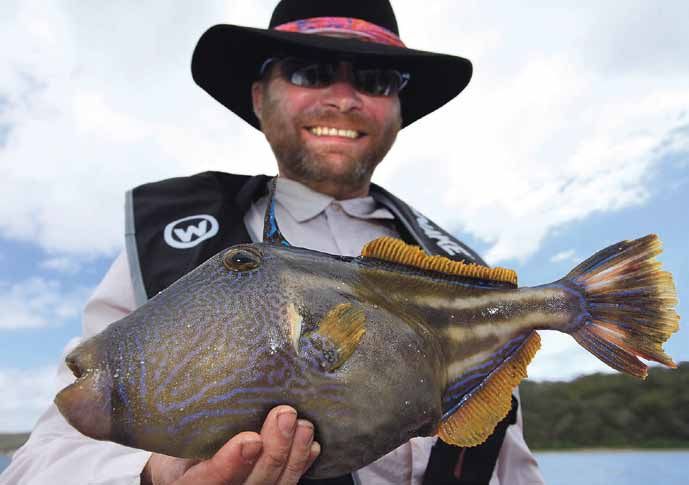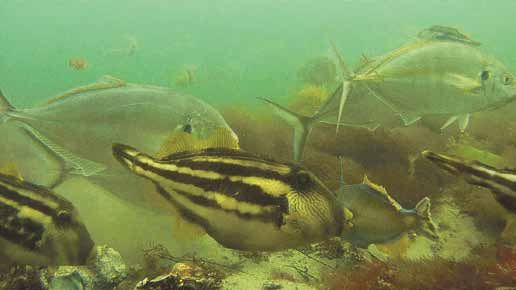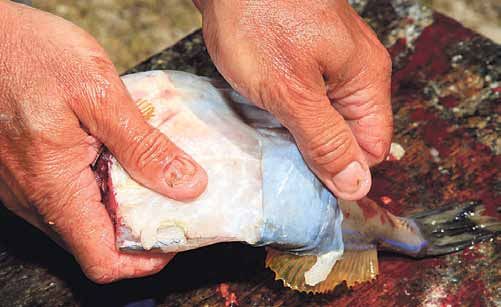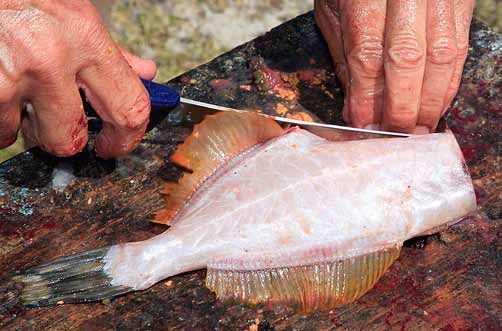 Presented from Issue 96
Presented from Issue 96
It is unlikely that if you mention you caught a ‘Leatherjacket’ to any Tasmanian salt water angler that they won’t know what you are talking about. The humble old leatherjacket, often called jackets, butterfish, triggerfish and my favourite “Larry” (Larry the Leatherjacket) is probably one of the most common fish available in Tasmanian waters, both estuarine and oceanic.
This amazing little creature of the sea has served itself as much amusement for many young anglers beginning their journey into the fishing world. I can remember as a kid sitting on many jetties and wharves watching leatherjackets feeding on the pylons and structure below; mesmerized by them. Then I would spend countless hours trying to fool them with my hook and bait. Most of the time they would swim out and nibble at the bait without touching the hook causing much frustration, this is where I learnt to change my tactics as a young angler determined not to be beaten by this fish, changing hook sizes, line, rigs and bait until I could hook one successfully.
This is where it all started and those basic principles I learnt then still apply to many fishing situations today, and I am sure I am not alone, its an aspect of fishing that I love to see even to this day when I wander around our local jetties, kids having fun catching leatherjackets.
These unusual looking fish are members of the Monacanthidae family, a name which has Greek origins meaning ‘one thorn’, and refers to the sharp spine on the top of their heads. There are more than 60 species caught around the Australian coast and in some of theses the males are brightly coloured with very intense patterns while the females are drab and dark coloured. The common name ‘Leatherjacket’ refers to their thick, tough, leathery skin, which doesn’t have normal scales and can be peeled off like a jacket. Would you believe that once upon a time the dried skin was used to polish wooden boats?
The leatherjacket is available in most waters all around the state and my home water, Georges Bay in St Helens, is a bit of a leatherjacket haven. That is often to the detriment of many of the soft plastic fisherman intent on using GULP soft plastics, these guys will have you going through a packet of GULP sandworms in no time flat without even the hint of a bite…..be warned. As a tackle store owner though, leatherjackets help the soft plastic sales enormously. The leatherjacket is available in Georges Bay all year round and is a staple table fish of many families; they are relatively easy to catch, are widespread all over the bay and are a great target for the kids.
They are great to eat as well.

Whilst fish of up to 3-4lb are regularly caught around the bay 1-2lb examples are most common and only require the most basic of fishing tackle to catch. When fishing for leatherjacket the use of long shank hooks is a must, sizes #2 - 6 are perfect, as the fish have very strong teeth and jaws and will bite through the line very easily. The long shank hooks give a bit more security against bite offs although I have seen fish bite clean through a hook shank. Just about any bait available at a tackle shop will work for leatherjacket, they tend not to be fussy eaters, I have found a piece of squid or peeled prawn flesh to be very effective, just be careful not to have any bait residue on the line anywhere near the hook as the fish will bite through your line. A basic paternoster rig with the sinker on the bottom and 1 or 2 hooks above it is all that is needed keeping the whole outfit nice and simple or if fishing a burley trail from the back of a boat an un-weighted bait floated down the trail can result in some great visual fishing.
Fishing for leatherjacket can be done with rod and reel or just as easily with a small hand line making it a very inexpensive form of fishing. They are not spooked by the boat and it is a delight to all to watch them mill around your bait. A bit of rough or weedy bottom is preferred.
Once caught the leatherjacket are quite easy to clean, using a sharp and strong knife slit the belly open from the anal opening up to the gills as you would when gutting any fish, then sit the fish upright on its belly and slice straight down behind the head and almost all the way through to the bottom, then as you tear the head away all the gills and guts should come away with it leaving you a headless gutless trunk with the skin still on. Now you need to remove the leathery skin, just try and peel an edge up then use your thumb to slide under the skin and separate the skin from the flesh, it will come away quite easily. What you will be left with is a headless, gutless, skinless trunk of beautiful white flesh which can either be left whole or filleted from this point.
The flesh from a leatherjacket is actually a quite highly regarded table fish, treated as a delicacy by many. The fillets are usually boneless, trunks usually have the backbone left in and can be cooked this way.
I like to fillet them, dust them lightly in flour, coat in egg and then use the FogDog Panko Breadcrumbs in a hot pan of Olive Oil and a knob of butter….. superb.
They are related to the highly-prized fugu fish of Japan (without any of the risk of poisoning) and the firm flesh has a mild flavour, low oiliness and is moderately moist. A versatile fish, they are good steamed, poached, pan-fried, stir-fried, deep-fried, baked, braised, grilled, barbecued or smoked. They are a good plate-sized fish cooked whole (head off) and this is the best way to bake or grill them where wrapping them in foil will help prevent them drying out. The firm flesh works well minced for fish cakes and fish balls and holds together well in soups, curries and casseroles.
I thought I would Google leatherjacket recipes and see what I could find. The recipe below is one by Tetsuya Wakuda and was part of a story by journalist Paul Denham.
If you haven’t heard of Tetsuya you have been living in a cave for twenty years. He is one of Australia’s best known chefs and own Tetsuya’s restaurant.
“This marinated leatherjacket recipe comes from my mother but she did it with chicken. I first had it when I was six or seven. My mother was a very good domestic cook. She is shocked that I picked this recipe, as it is really common in Japan. I grew up with this taste. I made her make it all the time, even though she didn’t want to. I was a bit spoilt. “In Japan, during winter, I have fugu, which is like the puffer fish. It’s poisonous and no one fishes it here. The leatherjacket is the closest in taste but you could also use flounder.”


Cleaning leatherjackets is a mystery to some, but with a bit of practise it is easily mastered.
Leatherjacket marinated with ginger and soy
Serves 4 4 medium-sized whole leatherjackets (about 150g each), gutted with heads, tails and fins removed
- 150ml soy sauce
- 100ml mirin
- 3 tbsp grated ginger
- 2 cloves garlic, grated
- 2 pinches white pepper
- 1 pinch salt
- 1 tsp white sugar
- 1 tsp sesame oil
- Plain flour, for coating
- Grapeseed or vegetable oil for deep-frying (about 2 cups)
- 2 limes and zest (optional), to serve
Chop each leatherjacket into four or five pieces.
(Use a cleaver for best results and chop through the bone.) Combine soy sauce, mirin, ginger, garlic, white pepper, salt, sugar and sesame oil in a small bowl and whisk until well combined. Pour marinade over fish pieces and toss to coat evenly. Cover and refrigerate for half an hour. Remove fish from the marinade and toss in flour to coat evenly.
Heat oil in a deep frying pan over medium heat until hot, about 170-180C. Fry fish in batches until golden brown and cooked through. Serve fish with lime wedges and a green salad and scatter over lime zest, if using.
So the next time you are out in Georges Bay, or anywhere else in Tasmania, and want to have a little bit if fun, entertain the kids or just want a basic feed of fish don’t overlook the humble old leatherjacket, it may just surprise you.
Jamie Henderson




